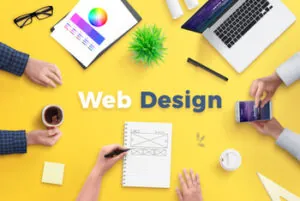In digital representation, particularly for dental practices, the significance of an impeccable website layout design cannot be overstated. A meticulously crafted website layout is the cornerstone of your online identity, guiding site visitors through a seamless and engaging experience. This blog delves into effective website layout design fundamentals tailored specifically for dental websites.
Embracing the Power of Visual Elements
A good website layout transcends aesthetics; it orchestrates visual elements and functionality. Key elements like the featured image layout, grid systems, and the clever use of negative space play pivotal roles in crafting a visually appealing and intuitive user experience. For dental websites, visual clarity and easy navigation are crucial in instilling confidence and professionalism.
 Embracing the Power of Visual Elements in Dental Website Layouts
Embracing the Power of Visual Elements in Dental Website Layouts
Visual elements are the building blocks of website design, particularly for dental practices. They are not just embellishments but crucial components that guide and influence the user experience. This expanded section explores how these elements can be effectively utilised in dental website layouts.
Harmonising Page Elements for Visual Coherence
In dental website layouts, page elements must be coherent and visually harmonious. This includes the careful placement of text, images, and interactive features. Consistency in design elements like colour schemes, font styles, and button shapes contributes to a professional look. For instance, a consistent colour palette reflecting the brand’s identity can make the website more memorable and trustworthy to site visitors.
Optimising Images for Enhanced Engagement
The choice and optimisation of images play a pivotal role in dental website layouts. High-quality, relevant images instantly grab the visitor’s attention and convey professionalism. For dental websites, this could mean showcasing images of the clinic’s interior, staff, or advanced dental equipment. These images should be optimised for web use, ensuring they load quickly while retaining visual quality, as slow-loading images can deter visitors.
Strategic Use of Negative Space
Negative space, around and between elements, is a critical aspect of website layout design. It’s not merely an ’empty’ space but a powerful tool to create a clutter-free and readable website. In dental website layouts, ample negative space around text and images can improve readability and focus attention on the most important content. It enhances the overall aesthetic, making the website more open and inviting.
Incorporating Visually Appealing Graphic Elements
Graphic elements like icons, shapes, and lines can add visual interest and aid in content organisation. In dental website layouts, these elements can be used to highlight services, direct attention to calls to action, or illustrate complex dental procedures in a more digestible manner. Custom graphics that align with the brand’s style can significantly enhance the website’s unique identity.
A Symphony of Visuals
In sum, the good website layout in dental website layouts is undeniable. When harmonised effectively, these elements make the website visually appealing and enhance its functionality and user engagement. A well-designed website reflects the dental practice’s quality of care and professionalism, making it an essential tool in attracting and retaining patients.
The Art of Asymmetrical Layout and Magazine Layout
The realm of website design is constantly evolving, and within this dynamic space, the asymmetrical and magazine layouts stand out as innovative approaches. These styles offer a refreshing deviation from the traditional, grid-bound structures, bringing a new level of creativity and engagement to dental website layouts.
Asymmetrical Layout: Breaking the Mould
Asymmetry in website design is about breaking free from the conventional balance and introducing an element of surprise and visual interest. In dental website page layouts, this can be achieved by offsetting text with images or using geometric shapes to create a unique visual flow.
Dynamic Visual Flow
Asymmetrical layouts create a dynamic visual flow that guides the eye across the page in an unconventional manner. This can be particularly effective in highlighting specific services or features of a dental practice. For instance, an asymmetrical layout idea might juxtapose a striking image of a dental procedure with a concise, impactful description on the opposite side, creating a compelling narrative for the site visitor.
Engaging the Z Pattern
Incorporating the Z pattern into an asymmetrical layout can further enhance user engagement. This pattern mimics the natural reading movement of the eye across the page. In a dental website, the top of the Z could feature the practice’s logo and navigation menu, the diagonal could highlight a key service with engaging imagery, and the bottom could present a call to action or contact information, ensuring a comprehensive yet captivating user journey.
Magazine Layout: Storytelling Through Design
The magazine layout borrows elements from traditional print media, offering a sophisticated framework for storytelling and information presentation. This layout is ideal for dental websites with extensive content, such as dental advice, patient stories, or detailed service descriptions.
Structured Yet Compelling Content Display
A magazine layout organises content in a structured yet visually compelling way. It integrates various elements such as headlines, subheadings, pull quotes, and images in a cohesive manner. For a dental website, this could mean featuring a headline about innovative dental treatments, followed by detailed articles with supporting images and patient testimonials, all arranged in an easy-to-navigate format.
Layout Ideas: Blending Function with Elegance
Balancing functionality with visual elegance is the key to a successful magazine layout in a dental website. It should look aesthetically pleasing and make the journey through the site intuitive and informative. Creative use of typography, colour, and spacing can make complex information more accessible and engaging.
A Fusion of Creativity and Practicality
In conclusion, asymmetrical and magazine layouts offer many creative possibilities for dental website design. By stepping away from traditional layout ideas and embracing these innovative approaches, dental practices can create websites that are visually striking, engaging, and informative for their visitors. When executed with skill and attention to detail, these layouts can transform a website from a mere digital brochure into an immersive digital experience.
Split Screen Layout: A Tale of Two Narratives
The split screen layout, a contemporary and versatile design element, has emerged as a unique way to tell two stories simultaneously on a single web page. This layout is particularly effective in dental websites, where contrasting or complementary narratives can be conveyed side by side.
Balancing Contrast and Harmony
Juxtaposition of Services and Testimonials
In a dental website, a split-screen layout can be ingeniously used to juxtapose different elements. One side could feature detailed descriptions of dental services, while the other could display patient testimonials or case studies. This approach provides comprehensive information and builds trust by showcasing real-life outcomes alongside service offerings.
Visual Balance and User Interaction
The key to a successful split-screen layout is maintaining a visual balance. Each side should complement the other, both in content and visual design. This could involve using contrasting colours yet maintaining a consistent theme across the page. The layout should also be intuitive, allowing users to interact seamlessly with both narratives without overwhelming them.
Enhanced User Experience with Interactive Elements
Dynamic Content Delivery
Incorporating interactive elements into a split-screen layout can significantly enhance user experience. For example, hovering over a service on one side could highlight a related testimonial on the other, creating an interactive and engaging experience. This makes the website more dynamic and helps guide the user through the content in a structured manner.
Mobile Responsiveness
With the increasing use of mobile devices, the split screen layout must be responsive. The content can be stacked or adapted on smaller screens to ensure that the dual narratives are still effectively conveyed without compromising usability.
Effective Visual Storytelling

A split-screen layout is an excellent tool for visual storytelling. By dividing the screen, you can lead the visitor through a narrative journey, starting with an introduction to the dental practice, then detailed service descriptions, and culminating in patient success stories. This layout allows for a compelling and cohesive storytelling experience.
Strategic Placement of Key Elements
The strategic placement of key elements in each panel is crucial. Important information such as calls to action, contact details, and key services should be placed strategically to catch user attention. This layout allows highlighting multiple key elements simultaneously without cluttering the page.
A Symphony of Stories on a Single Canvas
In conclusion, the split screen layout presents a unique opportunity for dental websites to weave two narratives into a cohesive visual experience. This layout can effectively engage and inform site visitors by balancing contrasting elements, incorporating interactive features, and ensuring mobile responsiveness. It’s a modern approach that brings a fresh perspective to dental web design, enhancing both the aesthetic appeal and the functional experience of the site.
Maximising Engagement with the Z Pattern Layout
The Z pattern layout is a powerful design principle in web design, particularly effective for dental websites. It leverages the natural reading pattern of the eyes, guiding visitors through a strategically structured visual journey. This section expands on maximising engagement using the Z pattern layout in dental web design.
Understanding the Z Pattern Dynamics
Natural Eye Movement for Optimal Information Delivery
The Z pattern layout capitalises on the natural tendency of the eyes to scan from left to right, starting at the top of the page. In the context of a dental website, this begins with a compelling header, typically featuring the practice’s logo and primary navigation. This is the first crucial touchpoint where visitors gain an impression of the brand.
Strategic Placement of Key Information
As the eyes move across the page, it is essential to place key information along these lines. The second point of the Z, typically the top right corner of the page, is ideal for essential calls to action – such as a ‘Book Appointment’ button. This ensures high visibility and encourages user interaction.
Implementing the Z Pattern in Dental Web Design
Showcasing Services and Specialties
The diagonal line of the Z pattern is perfect for showcasing the dental practice’s range of services and specialties. This can include brief descriptions or visually appealing icons that guide the visitor towards more detailed information, effectively using the layout to create a story about the practice’s capabilities and expertise.
Building Trust with Testimonials and Accreditation
The bottom horizontal line of the Z is a strategic location for building trust. This area can feature patient testimonials, accreditations, or awards. These elements reinforce credibility and reassure potential patients of the quality and reliability of the dental services offered.
Enhancing User Engagement and Conversion
Interactive Elements and Visual Cues
To further maximise engagement, interactive elements like hover effects on services or animated statistics about the practice can be incorporated along the Z pattern. Visual cues such as contrasting colours or unique typography can also guide visitors’ eyes and maintain interest as they navigate the website.
Optimising for Calls to Action
The final part of the Z pattern should lead to a compelling call to action. This could be an invitation to learn more about a specific treatment, a prompt to view a gallery of before-and-after photos, or a direct call to book an appointment. The placement of these elements is crucial to convert interest into action.
A Structured Path to Engagement
The Z pattern layout offers a structured and intuitive framework for designing dental websites. By understanding and applying the dynamics of natural eye movement, dental practices can create web pages that attract attention and guide visitors through a smooth and engaging journey, ultimately leading to higher engagement and conversion rates. When executed thoughtfully, this design strategy transforms a simple webpage into an interactive story about the practice and its services.
The Role of Grid Systems and Single Column Layout
In the intricate realm of web design, grid systems and single-column layouts stand as pillars of structure and simplicity, respectively. When applied to dental websites, these design frameworks can significantly enhance aesthetics and functionality. This expanded section delves deeper into how these layouts can be optimised for dental practices.
Harnessing the Power of Grid Systems
Structured Elegance in Design
Grid systems offer a structured approach to layout design, ensuring that all elements on the web page align harmoniously. This translates to an organised presentation of services, information, and visuals for dental websites. The grid system aids in creating a balanced, easy-to-navigate interface that can accommodate various content types – from text and images to videos and infographics.
Responsive Design for Optimal User Experience
A major advantage of grid systems is their inherent flexibility, which is important for ensuring responsiveness across different devices. Dental websites must cater to users accessing information on various screen sizes, from desktops to mobile phones. Grid systems facilitate a fluid transition between these devices, ensuring content is displayed optimally.
Single Column Layout: Clarity and Focus
Streamlined User Journey
The single-column layout, by contrast, offers a streamlined, focused approach. This layout is particularly effective for mobile users, presenting content clearly and linearly. For a dental website, this means that information is delivered in a digestible, straightforward manner, guiding the visitor through the site without distractions.
Enhanced Readability and Engagement
A single-column layout significantly enhances readability. On dental websites, where clear communication of services, booking information, and patient care tips is crucial, this layout ensures that the information is not only accessible but also engaging. The linear content progression also allows for a natural storytelling approach, which can be particularly persuasive in presenting patient testimonials or detailed service descriptions.
Combining Grid Systems and Single Column Layouts
Adaptive Design Strategies
The most effective dental websites can combine the strengths of both grid systems and single-column layouts. A grid system can be employed on larger screens to create a rich, multi-faceted experience. As the screen size decreases, the design can adapt to a single-column layout, maintaining usability and readability on smaller devices.
Consistent Aesthetic Across Devices
This adaptive approach ensures the website maintains a consistent aesthetic and functional experience across all devices. It respects the user’s need for clear, accessible information, regardless of how they access the website.
A Blend of Functionality and Aesthetics
In conclusion, the thoughtful application of grid systems and single-column layouts can greatly enhance the design and functionality of dental websites. These frameworks offer a blend of aesthetic appeal and practicality, ensuring that information is presented in an organised and visually pleasing manner and accessible and engaging for all users. By carefully considering these layout options, dental practices can create websites that effectively communicate their message and services, catering to the needs of a diverse online audience.
Visual Hierarchy: Leading the Eye
In web design, establishing a visual hierarchy is essential. This involves arranging graphic elements that naturally leads to the site. Creating a visual hierarchy is a fundamental aspect of web design, particularly for dental websites where conveying information clearly and effectively is paramount. This expanded section will delve into the nuances of establishing a visual hierarchy that attracts and effectively guides the viewer through the content.
Establishing Focal Points
Prioritising Key Information
The essence of visual hierarchy lies in how elements are arranged to prioritise key information. For a dental website, this could involve highlighting critical services, showcasing special offers, or drawing attention to booking procedures. These focal points become the anchors of the viewer’s journey by manipulating size, colour, and placement.
Using Contrast to Attract Attention
Contrast is a powerful tool in creating focal points. A high-contrast area on a dental website can draw the eye to important features like emergency dental services or new patient information. This is achieved through bold colours, distinctive fonts, or dynamic images that stand out from the rest of the page.
Structuring Content for Clarity
Logical Flow of Information
Organising content in a logical, easy-to-follow manner is crucial. The viewer’s journey should be intuitive, from general information about the dental practice to more specific details about services and qualifications. This logical flow aids in the comprehension and retention of information.
Balancing Text and Imagery
In a dental website, the balance between text and imagery is vital. While images can be engaging, too many can overwhelm the viewer and detract from key messages. Similarly, large blocks of text can be daunting. Striking the right balance ensures the website is informative and visually appealing.
Implementing Typography to Guide the Viewer
Hierarchy in Typography
Typography is a subtle yet powerful element in creating a visual hierarchy. Using different font sizes, weights, and styles can clearly delineate headings, subheadings, and body text, guiding the viewer through the content coherently. For dental websites, clear and legible typography is essential to convey professionalism and trustworthiness.
Colour and Typography
Colour can enhance typographical hierarchy. Using brand colours for headings or key phrases reinforces brand identity and aids in navigation and emphasis of important content.
Integrating Negative Space for Emphasis
Breathing Space for Content
Negative space, or the space around and between elements, is not just an aesthetic choice; it’s a crucial component of visual hierarchy. In dental websites, using negative space effectively can make the site appear less cluttered, allowing key information to stand out and enabling the viewer to digest information and relax.
Enhancing Readability and Focus
Proper negative space enhances readability and focuses attention on the most important elements, like patient testimonials or detailed descriptions of dental procedures. This strategic use of space can significantly improve the user experience.
Crafting an Intuitive Visual Experience
In conclusion, establishing a strong visual hierarchy is essential in dental web design. It involves the aesthetic arrangement of elements and the strategic planning of how these elements guide and inform the viewer. A dental website can become an intuitive, informative, visually engaging platform that resonates with its audience by effectively using focal points, structured content, typography, and negative space. By mastering these principles, dental practices can create a website that looks professional and communicates its message clearly and effectively.
Conclusion: Balancing Aesthetics and Functionality

Your website is more than just a digital front for your dental practice; it reflects your commitment to quality, professionalism, and patient care. It’s where first impressions are formed and where patient relationships begin. In this digital age, having a website that effectively communicates your services, ethos, and expertise is no longer just an option; it’s necessary.
This is where Mediboost comes in. Our expertise lies in transforming your vision into a digital reality, ensuring your website is not just a collection of web pages but a cohesive, engaging, and informative platform that resonates with your patients. Mediboost is dedicated to creating a website that meets and exceeds your expectations from the initial concept to the final design.
Keep your dental practice from getting lost in the digital shuffle. Stand out with a website that truly represents the quality of your services and the essence of your practice. Contact Mediboost at 1300 163 058 and take the first step towards crafting your digital masterpiece. Let’s create a website that attracts patients and tells the story of your practice in the most compelling way. Call us today, and let’s embark on this transformative journey together.
References:
https://www.linkedin.com/pulse/psychology-visual-hierarchy-design-designwithpro
https://www.sciencedirect.com/science/article/pii/S1877050917326650


 Embracing the Power of Visual Elements in Dental Website Layouts
Embracing the Power of Visual Elements in Dental Website Layouts
